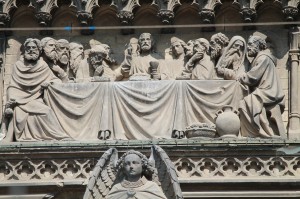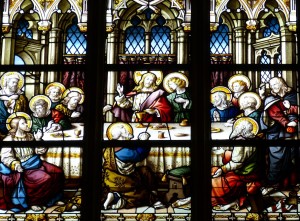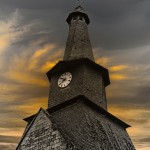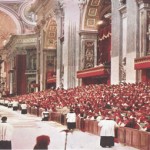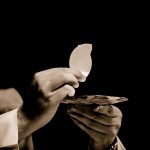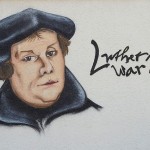Introduction
The question of Christ’s presence or location in the Eucharist is common among theologians and readers of theology. Is Christ really present in the sacrament? If so, how? Such debate has similarly been central to ecumenical dialogue: transubstantiation, consubstantiation, memorial feast, realpresence, and spiritual presence represent varying answers to the conundrum. Rather than disagreeing about the nature or form of elemental transformation or the spiritual aspects of the Eucharist, ecumenical dialogue should instead focus on affirming the presence of Christ through the power of the Spirit to the glory of the Father. George Hunsinger offers a masterful attempt in The Eucharist and Ecumenism to find common ground amid these viewpoints while also capturing the thickness of the Sacrament.[i]
Such concrete attempts to locate Christ in the sacrament fall short of the depth of the Church’s liturgical worship however. The ordo, or structure of the church’s ancient liturgy, cannot be divvied up into smaller portions in an attempt to find Jesus or to use some elements while removing others. The ordo has an inherent meaning to it that cannot be separated out or watered down.[ii] Christ is fully present throughout the entirety of the liturgy because the liturgy in its entirety is considered to be the Eucharist. Any meaningful conversation about the location of Jesus in the Eucharist must see the Eucharist as the whole of the service rather than just one prayer or moment of consecration.[iii]
This article will seek to argue that not only is Christ really present in the Eucharist, but he is present in a plurality of forms and ways. Ultimately his presence is made known in the ritual sacrament in its most tangible and mysterious form, but he is also present in the assembly, (through the presiding minister), and by the reading and proclamation of his word.[iv] By understanding his location in such light, we as the Church are then able to articulate his presence more fully and embody his presence in the world he loves and is coming back to redeem.
Synaxis
Our first encounter with the person of Christ is found in the very gathering of the ecclesia for Sunday worship: the synaxis. As the people of God join together for the corporate praise and worship of Almighty God they become the Church in a very real and tangible sense. Our Lord said, “For where two or three are gathered in my name, I am there among them” (Mt 18:20 NRSV). Scripture also tells us that God is “enthroned on the praises of Israel” and that Jesus is the head of the Church.[v] In short, in becoming one, we become the very body of Christ. With Jesus as the head we are his agents, his singular vehicle of mission and ministry in the world.
In leaving the world and entering into praise and worship, the individual joins in with the koinonia (communion/fellowship)of the Trinity and the Church meeting the Risen Lord as the many become one. St. John tells us: “…the Word became flesh and lived [read: tabernacled] among us” (Ps 22:3, Col 1:18). Through the empowering presence of the Spirit we believe that Jesus continues to tabernacle in, with, and among his people. The opening acclamation—“Blessed be God: Father, Son, and Holy Spirit. And blessed be his kingdom, now and forever. Amen.”[vi]—as well as the opening songs of praise locate the entire assembly within the triune Godhead and the ongoing, unending praise of the cosmos. The opening acclamation and call to worship identifies and realizes the synaxis in a different dimension of time and space: it is real time and space in the presence of Almighty God. As Fr. Schmemann has pointed out in The Eucharist, the use of “Amen” by the people is not simply a space-filler, it is an affirmation of “Yes, this is so, and let it be so.”[vii]
Word
Jesus is the second person of the Trinity, He is the divine logos poured forth from the mouth of God who created all that is and ever shall be. The majestic language of John’s prologue demonstrates the nature of such presence as the logos and within the ordo we encounter Christ through the public reading and proclamation of God’s word. The Word did indeed become flesh, but he is still the logos. The versicle (responsive statements) at the end of the Old Testament and Epistle lessons points to such reality: The reader says, “The Word of the Lord” and the faithful reply, “Thanks be to God.” We are truly giving thanks for the presence of God’s Word in the assembly; the reading of God’s word means that God’s Word is present in and among his people.
Hebrews claims, “The word of God is living and active, sharper than any two-edged sword” (Heb 4:12). Through Isaiah, YHWH says, “So shall my word be that goes out from my mouth; it shall not return to me empty, but it shall accomplish that which I purpose, and succeed in the thing for which I sent it” (Is 55:11). The Liturgy of the Word is thus ministry in action. It is not the preamble to Communion but rather it is one of two pinnacles or climaxes within the liturgy and should be received as the presence of Christ. In fact, it is against the tradition of the Church and liturgical rubrics to celebrate the Eucharist without first reading from Scripture. One cannot proceed to the Altar without first having been fed by the Word—the two cannot be separated.
The same should be said of the sermon. There should be no difference between the reading of God’s word and the kerygmatic proclamation of the word by the preacher. Perhaps the preacher should also conclude her sermon by saying, “The Word of the Lord,” to which the people reply, “Thanks be to God.” The Reformers certainly had this point right when they stated that “the marks of the true church [are] that the Word of God should be preached, and that the sacraments be rightly administered.”[viii] The connection between synaxis and Word is quite clear. Once the gathered faithful have been fed by the proclaimed word, the service naturally turns toward the second pinnacle of the ordo —the Feast of the Word, the celebration of the Lord’s Supper.
Sacrament
If we believe with Fr. Schmemann that the Eucharist is the sacrament par excellence of the Church, the Sacrament of sacraments and the very place where the Church becomes that which she already is,[ix] then we ought to have a thorough understanding of Christ’s location therein.[x] It is safest to dwell in the realm of mystery on this point. The move toward embracing mystery is not a philosophical or theological abandonment, but rather the simple admission that God’s ways and thoughts are higher than ours (Isaiah 55). Nor is Mystery a weakened, watered down version of transubstantiation nor is it akin to riding on the fence between two extremes. Christ can still be fully and really present in the bread and wine without requiring a solid answer as to “how” such a thing is possible.
The celebrant begins the Eucharistic Prayer with the Anaphora, the Great Thanksgiving when the Sursum Corda is said: “Lift up your hearts.”[xi] The response is beautiful: “We lift them up to the Lord.” Liturgiologists and liturgical theologians have believed that this proclamation locates the assembly within the eternal Throne Room of Almighty God. This is further evidenced by the singing (or saying) of the Sanctus which echoes the words of Revelation 4-5, “Holy, holy, holy Lord. God of power and might, heaven and earth are full of your glory. Hosanna in the highest.”[xii] This is the song that the heavenly host sings before the Throne without ceasing and the Church is caught up into and joins that heavenly chorus. We know from Scripture that Christ is seated at the right hand of the Father and therefore in the act of Sursum Corda and Sanctus the assembly also is in his presence.
The celebrant then moves into a recounting of YHWH’s mighty acts throughout history, ultimately culminating in the incarnation, life, and crucifixion of Jesus. The prayer brings to mind the Last Supper when Jesus instituted this holy meal. Our Lord said, “Do this in remembrance of me.”This act of anamnesis, of powerfully and actively remembering, is what drags the past into the present and makes known and real the one true sacrifice of Jesus. Jesus is not re-sacrificed weekly but rather his sacrifice is weekly re-presented. The eschatological outlook of the Eucharistic prayer awaits the day when God will be all in all, when Christ will return to make all things new, and when the faithful shall dine at the banquet table with their bridegroom. The future is a necessary component of all Eucharistic celebration because we are a hope-filled people awaiting the “resurrection of the dead and the life of the world to come.”[xiii] The past and future acts of Christ come crashing into present and therefore make him present as well.
The epiclesis (invocation of the Holy Spirit; e.g. “Send your Spirit upon these gifts…” ), no matter where it is placed, focuses on the transformation of the Bread and Wine into the Body and Blood of Christ by the power of the Holy Spirit. There is no reason to believe that our Lord was being esoteric when he said, “This is my Body…this is my Blood.” We are not forced into elemental transformation where the form remains the same but the accidents do not. Nor are we confined to believing that the only transformation to take place is in the heart of the believer—though that would be easier. Rather, we are left to believe that the Bread is still bread and the Wine is still wine and yet somehow, someway they are the Body and Blood and that Christ is present in them. Christ’s presence in the sacrament has been made known and realized long before the prayer over the elements and people ever take place. The liturgy concludes with the dismissal of the people out into the world as Christ’s body—this is not truly the end of the liturgy but the beginning of a new chapter, the liturgy after the liturgy, through which we are called to be agents and partners with God’s will and mission.
Conclusion – Real Presence, Plural Presence
The question at hand, then, is not “is” Christ present or “how” is he present, but rather, “Are we willing to accept and encounter the plurality of his presence?” Any attempt to locate Jesus concretely or specifically in the Eucharistic elements is beyond the pale of Scripture and the ancient witness of the Church. The strongest claim that one can make is that he is present in the elements but the method or means by which are mysteriously unknown. Real presence would be the via media between the certainty of trans- and consubstantiation and the thin outlook of the memorial feast and spiritual presence. Christ is not only present in the elements, though you shall certainly find him there, but he is also really present throughout the liturgy in various places, ways, forms, and manners.
A separation between Word and Sacrament occurs when we focus our conversation of presence on a moment or action in the Eucharist.[xiv] Christ is not absent from the Liturgy of the Word and to suggest otherwise is to relegate the readings and sermons to the opinion of man. A robust understanding of a dually climactic liturgy, of both Word and Sacrament, will lead to a deeper acknowledgment of Christ’s pluralistic presence in the Eucharistic ordo. Our Lord is present in, among, by, with, and for his creation and we should expect nothing less from the summit of our praise and worship.
Ultimately the Church is sent forth from her walls that she might embody God’s love “for the life of the world.”[xv] As agents of transformation and grace, we are called to share the Good News of God in Christ with neighbors and strangers alike, inviting them into the family of God, and ultimately partaking with them in a foretaste of the eschatological banquet. By understanding his location in such light, we as the Church are then able to articulate his presence more fully and embody his presence in the world he loves and is coming back to redeem.
This piece was originally published in Resonance: A Theological Journal in the Winter 2015 edition. My heartfelt gratitude goes to Micah Lunsford, a fellow Fuller graduate and the Editor of Resonance.
[i]George Hunsinger, The Eucharist and Ecumenism: Let Us Keep the Feast, Current Issues in Theology (New York: Cambridge University Press, 2008).
[ii]Aleksandr Shmeman, Introduction to Liturgical Theology, 3rd ed., trans. Asheleigh E. Moorhouse (Crestwood, NY: St. Vladimir, 1986, ©1966), 19.
[iii]Aleksandr Shmeman, The Eucharist–sacrament of the Kingdom (Crestwood, N.Y.: St. Vladimir, 1988, ©1987), 31.
[iv] I have elected to include the presiding minister parenthetically because such a topic would require far more time and attention than we can give at this moment. Suffice it to say that varying viewpoints on the efficacy or ontology of presbyters is far too large in scope to cover here. That being said, I do believe the priest is an icon of Christ but I do not believe that it is an icon associated with masculine or male-dominated imagery. Cf. Bruce T. Morrill, Encountering Christ in the Eucharist: The Paschal Mystery in People, Word, and Sacrament (New York: Paulist Press, ©2012).
[v] Psalm 22:3 and Colossians 1:18.
[vi]The Book of Common Prayer and Administration of the Sacraments and Other Rites and Ceremonies of the Church: Together with the Psalter or Psalms of David According to the Use of the Episcopal Church (New York: Church Hymnal Corp., [1979]), 355.
[vii] Schmemann, The Eucharist, 48.
[viii] Calvin, Institutes of the Christian Religion via Alister E. McGrath. Historical Theology: An Introduction to the History of Christian Thought. Oxford: (Oxford: Blackwell Publishers, 1998) 205.
[ix] That is, in Christ the Church already is the Church but she becomes or realizes herself as the Church in the celebration of the Eucharist.
[x] Schmemann, The Eucharist, 29.
[xi] A better translation is the simple imperative, “Up hearts!”
[xii] 1979 BCP, 362.
[xiii] As stated in the Nicene Creed.
[xiv] Schmemann, The Eucharist, 27-28.
[xv] Aleksandr Shmeman, For the Life of the World: Sacraments and Orthodoxy, 2nd ed. (Crestwood, NY: St. Vladimir, 1973 (1982 Printing)),.

